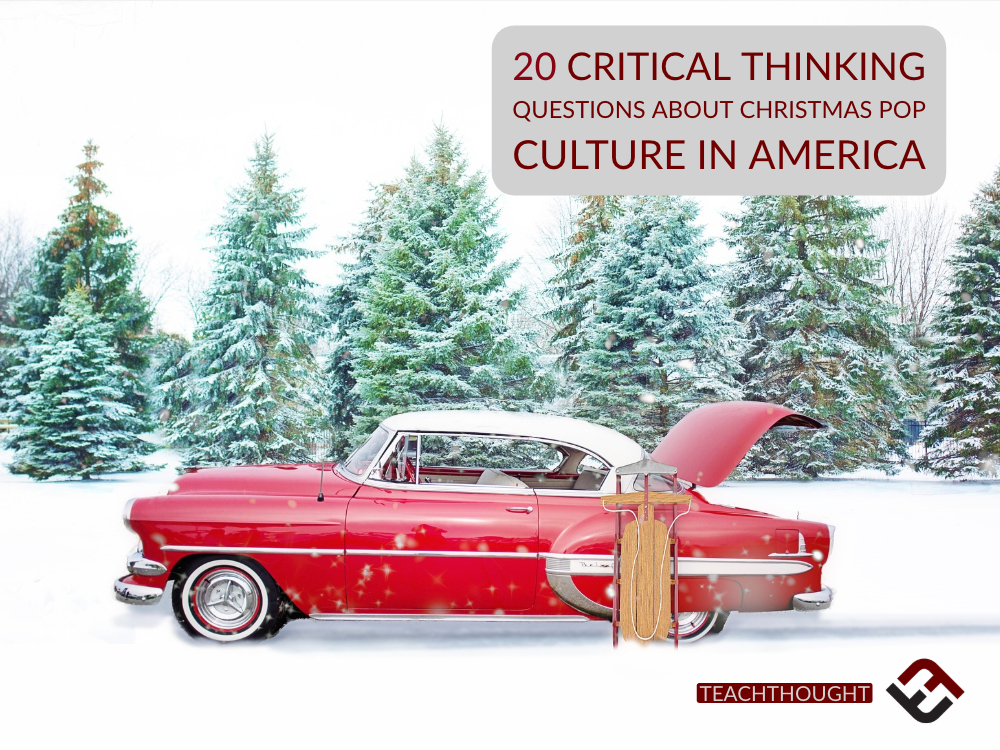
Consider These Critical Thinking Questions About Christmas Pop Culture In The United States
by Terry Heick
Simple premise: Allow your students to think critically about the American pop culture holidays.
I tried to make the questioning fairly ‘content area-agnostic’ so they could be used in different classes. I also stayed away from any discussion of religion or politics for obvious reasons. This is about culture and critical thinking and my hope is that some of the questions could help you and your students brainstorm similar questions of your own and that those questions could lead to activities, essays, debates, or projects in lieu of traditional ‘crossword puzzle/word find’ holiday traditions in the classroom.
You can also use the TeachThought Learning Taxonomy to create some of your own. Feel free to use it with older students to develop their own critical thinking questions about the American Pop Culture holidays.
Also, please note–none of these questions are intended to draw pure criticism about the holidays, culture, etc. The goal is to encourage students to think carefully about the things they do, participate in, concede, allow for, enable, contribute to, and otherwise make a part of their lives. (There’s a difference between criticism and critical thinking.) The goal is simply to get students to think about themselves and the world around them.
See also 12 Ideas For Holiday Activities In The Classroom
On to the questions.
20 Questions To Help Students Think Critically About American Pop Culture Holidays
1. Which holiday movie is a more authentic representation of modern American culture, ‘It’s a Wonderful Life’ or ‘Christmas Vacation’? Look beyond setting (time and place) and examine the themes and implied messages embedded in the stories and acting performances to create your response.
2. How has the concept of ‘the holidays’ changed in the United States? What forces have caused that change?
3. Choose one holiday and predict what it might ‘look like’ in 25 years? In 100 years? Explain what primary forces will shape those changes and defend why you think those changes might occur. Bonus points for using patterns of past change to predict future change.
4. Analyze one holiday from three of the following frameworks: Theology, Culture, and Economics.
5. Analyze the most common traditions around a given holiday based on a given perspective. That is, state the holiday (e.g., Thanksgiving or New Year’s Eve) and perspective (historical or economic), then analyze the given customs based on that perspective. Bonus: suggest which customs should be preserved, which should be eliminated, and which should be revised or replaced and why.
5. What role do customs and traditions play in both holidays and American culture? Are they a good thing? Has that answer changed over time? What should change over time and what should not. Bonus points: Use Shirley Jackson’s ‘The Lottery’ to defend your response.
5. Many people disagree about religion, consumerism, the ‘true meaning’ of the holidays, etc. Whose perspective about ‘the holidays’ is valid and why?
6. What are the ‘parts’ of the holidays? Analyze them from a given perspective. Factors could include culture, chronology, geography, weather, economics, color, light, sound, food, etc. Be specific and give concrete examples.
7. What is the relationship between The Grinch and his dog? Who’s more important to the story and why? What were the primary causes for the Grinch’s change over the course of the story? What factor did metacognition and self-awareness play in his growth?
8. From the movie A Christmas Story, analyze the symbolism of ‘the lamp.’ How does it function differently as a symbol both within the story (as a symbol for the characters) and outside of the story (as a commentary on American culture during that time)?
9. Explain how ‘It’s a Wonderful Life’ both reinforces and challenges prevailing social norms both then (release date) and today.
10. Argue for or against: We need more/different/better Christmas music.
See also 8 Tips For Integrating Pop Culture In The Classroom
11. How might different cultures around the world view American holiday customs different than Americans do? Why might these differences exist? What can Americans learn from those differences in perspective that might help them better understand other cultures?
12. Argue for or against: The main character’s mother in ‘Home Alone’ is a ‘good mother.’ Bonus: How does the movie ‘treat’ (or encourage the viewer to view) the father differently from the mother?
13. Argue for or against: The magician (Professor Hinkle) from ‘Frosty’ is an anti-hero? Put another way, who’s the hero of ‘Frosty’ and why?
14. Explain how technology has changed the cultural perception of holidays. Challenge yourself to reach beyond the obvious ‘social media/shares pics’ low-hanging fruit analysis.
15. Who’s the bigger hero, Rudolph the Rednose Reindeer or Clark Griswold? Be sure to clarify your definition of a hero before making your case about who better fits that definition?
16. How would ‘Baby it’s cold outside’ be ‘heard’ differently today than when it was released in 1944?
17. Compare and contrast ‘Twas The Night Before Christmas’ (i.e., ‘A Visit from St Nicholas’) and Metallica’s ‘Enter Sandman.’
18. Create a soundtrack using modern music for ‘A Charlie Brown Christmas.’ Use at least six songs, explain at which point each should be played, and defend your choices. Alternative: Would the lives of the characters from ACBC be better or worse with WiFi. Explain your perspective.
19. What do holidays communicate about the human condition?
20. Create one new custom or tradition that you can bring into your life/family that has the ‘staying power’ to endure over a lifetime, and explain why you believe it has that kind of endurance. Use other customs and traditions (both within and beyond your family) as models to draw from.
20 Critical Thinking Questions About American Pop Culture Holidays
